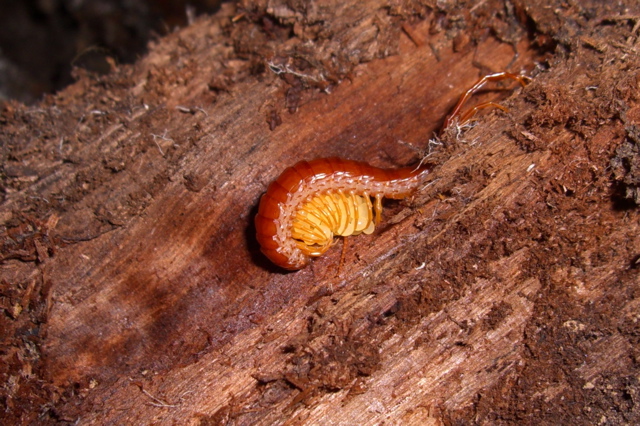 Please see Part 1 of this article for more on Giant Centipedes, Scolopendra gigantea, including escape stories and a video of a bat-hunting centipede in Trinidad.
Please see Part 1 of this article for more on Giant Centipedes, Scolopendra gigantea, including escape stories and a video of a bat-hunting centipede in Trinidad.
Centipede Diversity
Over 3,000 species, classified within the invertebrate order Chilopoda, have been identified to date. Many more will certainly come to light in time – several years ago a new centipede was discovered in the heart of New York City’s Central Park (please see article linked in Part 1). All, including the thinly-built and ubiquitous House Centipede (please see photo in Part 1), are capable of inflicting painful bites; fatalities, while unlikely, have occurred.
Centipedes have obviously hit upon a very successful survival strategy – as a group, they pre-date the dinosaurs, and have remained largely unchanged for over 400 million years.
Centipedes in Zoos
Those species that I’ve kept in zoo collections did best in exhibits that allowed for the creation of deep burrows. A thin exoskeleton and their inability to close off the spiracles renders centipedes prone to dehydration.
Natural history journals recount epic battles between centipedes and mice, tarantulas (please see video linked below), frogs, snakes and other hefty prey items, but captives fare well on a diet comprised of earthworms, crickets, roaches and other invertebrates.
In properly-designed displays under night-simulating lighting, centipedes are fascinating to observe, but they are not well-suited to private collections (please see below).
Centipedes in the Pet Trade
I do not recommend centipedes as pets, for reasons I’ll discuss in a moment. The centipedes available in the pet trade are most often members of the Genus Scolopendra. The commonly-imported Amazonian Giant Centipede, Scolopendra gigantea, is the world’s largest; the stoutly built females may top 12 inches in length. This venomous, ever-hungry brute has a wide range in Latin America and also occurs on several Caribbean Islands (but don’t look for its photo in any vacation travel brochures!).
Others that are sometimes kept by hobbyists include Eurasia’s Scolopendra cingulata and S. heros of the southern USA. However, identification is difficult even for specialists, and as many as 6 species have been sold under a single trade name (a fact which complicates the treatment of bites). Identification is further muddled by the vast array of colors – brown, gold, yellow, orange, purple, green – which individuals of a single species may exhibit.
Cautions: Life-Threatening Venom
 Centipede bites and escapes are common in captive situations…they are simply very difficult animals to deal with. Add to this the fact that we know little about the complex venoms and skin-irritating chemicals they produce, and you can see why these interesting creatures are best left to the care of professionals.
Centipede bites and escapes are common in captive situations…they are simply very difficult animals to deal with. Add to this the fact that we know little about the complex venoms and skin-irritating chemicals they produce, and you can see why these interesting creatures are best left to the care of professionals.
Bites from several species, including Giant Centipedes and others in the pet trade, have caused fevers, dizziness, cardiac problems and breathing difficulties, and fatalities have occurred; personal allergies are also a possibility (please see article below). A colleague of mine, bitten by an unidentified centipede in Brazil, lapsed into a coma and is fortunate to have survived.
As species identification and treatment are little-studied, keeping centipedes is a gamble not worth taking. By all means spend time watching them in public collections, but seek employment in a zoo if you wish practical experience. Please ignore the internet videos of people handling centipedes – promoting this is beyond irresponsible.
Further Reading
Discovery Video of a Giant Centipede catching and devouring a tarantula.
Centipede Bites (case studies).
Centipede image referenced from wikipedia and originally posted by Eric Guinther (Marshman)
Centipede protecting eggs image referenced from wikipedia and originally posted by Marshal Hedin
Tales of Giant Centipedes – Bat-Stalkers, Escapees and Words of Caution – Part 2
That Reptile Blog



















